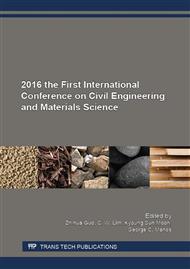p.49
p.53
p.58
p.63
p.68
p.73
p.78
p.83
p.88
Effects of Concrete Mix Proportion on Electrical Resistivity of Concrete
Abstract:
Electrical resistivity is one of the important parameters for modeling corrosion behavior of concrete. Few researchers have been carried out to investigate this problem. This paper presents an experimental study on effects of concrete mix proportion on electrical resistivity of concrete. The electrical resistivity of concrete is measured using the four Wenner probe, which is a fast and simple test that evaluates the resistance of concrete against the entrance of ionic species. The varied parameters in this study were water/binder ratio, fly ash content, cement paste content (Υ) and curing conditions. Based on experimental results, a good correlation is obtained between electrical resistivity and compressive strength of concrete.The results showed that the electrical resistivity of concrete mainly depend on compressive strength and fly ash content. The results of this study can be used further to model the behavior of electrical resistivity of concrete when the mix proportions are provided and that can be supported information to design sacrificial anode protection system.
Info:
Periodical:
Pages:
68-72
Citation:
Online since:
August 2016
Authors:
Keywords:
Price:
Сopyright:
© 2016 Trans Tech Publications Ltd. All Rights Reserved
Share:
Citation:


